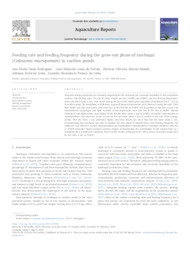Feeding rate and feeding frequency during the grow-out phase of tambaqui (Colossoma macropomum) in earthen ponds.
Feeding rate and feeding frequency during the grow-out phase of tambaqui (Colossoma macropomum) in earthen ponds.
Summary: Adequate feeding protocols are extremely important for the technical and economic feasibility of fish production systems. Two feeding rates, 3% and 4% body weight per day (3%BW and 4%BW), and two feeding frequencies, twice and three times a day, were tested during 84 days at the initial grow-out phase of tambaqui (94.5 ± 6.4?g) in earthen ponds. No mortalities or difference in growth between treatments were observed during the trial. Total feed intake and feed conversion ratio were low in the fish fed at 3%BW. Fat deposition in the fish carcass and concentration of glycogen and lipid vacuoles in the hepatocytes were also low in fish fed at 3%BW. Plasma cholesterol and triglycerides were higher in the fish fed three times a day at 4%BW. Increased concentration of malonaldehyde was observed in the carcass of fish fed three times a day at 4%BW at the end of the storage period. Fish fed twice a day presented higher total feed intake per meal than fish fed three times a day, demonstrating that tambaqui was able to regulate the feed intake to benefit from a low feeding frequency. No difference was observed in pond phytoplankton and zooplankton concentration or sediment chemistry. Fish fed at 3%BW presented higher stomach content weight, demonstrating the contribution of the natural food as a complementary nutrition to tambaqui. Based on the results, tambaqui of 95–350?g reared in earthen ponds may be fed twice a day at 3%BW.
Publication year: 2024
Types of publication: Journal article
Observation
Some of Embrapa's publications are published as ePub files. To read them, use or download one of the following free software options to your computer or mobile device. Android: Google Play Books; IOS: iBooks; Windows and Linux: Calibre.
Access other publications
Access the Agricultural Research Database (BDPA) to consult Embrapa's full library collection and records.
Visit Embrapa Bookstore to purchase books and other publications sold by Embrapa.

